David's Astronomy Pages
|
Notes (S296) |
Notes (Main) |
Home Page |
Notes (S304) |
|
Image Linking - Raw Images for Target Centering Image Linking - Reduced Images for DY Per variable star analysis >
It had been noticed over several sessions that
there was some underlying issue associated with the realtime 'Linking' of locate
images recorded for the purpose of high precision centering of target stars.
Particular images containing seemingly adequate number of stars would fail to
image link using Insert WCS method on both USNO or GSC catalogs), although they
would often link successfuly solve using Fail Safe method. The impact of
the issue was several-fold:
a) annoying delays (up to 8 minutes in total during a 3 hour session)
- most significantly delays whilst Image Link unsuccessfully
tried out numerous alternative Link configurations
- but also delays whilst extra Locate Images were taken in an
attempt to meet high-precision pointing requirements (ie <0.6 arc sec
error)
- delays whilst additional Locate Images were taken with ever
increasing exposure time (eg 10s, 20s, 30s)
b) suboptimally positioned images, where high precision pointing was not
achieved, potentially leading to poorly framed images, or unusable images
because one or more reference stars lie outside the captured frame.
During S301 session (-15 deg C) a total of least
8 minutes of non-productive time (NPT) can be ascribed to the problem.
Given that session was terminated early due to cloud, the loss of 8 minutes of
useful imaging time is equivalent to the loss of image sets for 1-2 target
objects. In comparison the time lost during S294 session (-20deg C)
totalled only 2.5 minutes. Whilst this is a smaller loss, it is nevertheless
still a very much unwanted loss.
Previous workarounds to mitigate some of the delays associated with failed
matches and prevent suboptiminally positioned images have worked quite well, but
the large delays associated with failed attempts to Insert WCS remained.
Finally tired of this annoying issue, the problem was thoroughly investigated following session S301.
A review suggested that the problem seemed to effect sessions with warmer CCD temperature (eg -15 deg C) more so than sessions with colder CCD temperature of -20 or -25 degC. This has subsequently shown to be due to more numerous /more significant hot pixels associated with warmer images which results in more false stars causing both higher computing overhead and more failed matches during linking attempts.
| Raw Image (star field
with R CrB) Despite the reasonable number of star objects, the images failed to link using normal Source Extraction (SExtractor) settings (Note: the large number of hot pixels in the raw image) |
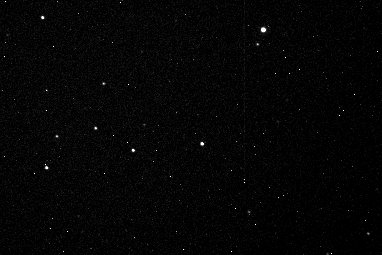 |
| Raw CCD Image 20s, 2x2 binning, C Filter, 2008-09-11 21:40h UT (#301102) |
| Equivalent star field
in TheSky (Software Bisque) 10 stars (with Mag < +15) are available for image linking The stars can be reasonable easily recognised in the raw image above, so why should Image Linking fail ? |
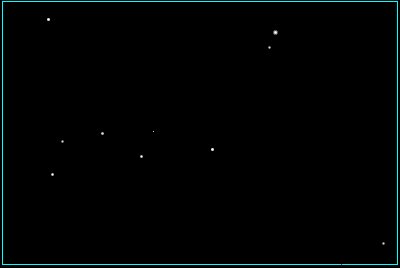 |
| Raw Image - showing
Inventory Stars (CCDSoft, Software Bisque) (Min. number of pixels above threshold = 4, Detection Threshold = 1.25 ) Note the large number of hot pixels that are picked up as Inventory Stars. These are numerous enough to cause Image linking / Insert WCS to fail. |
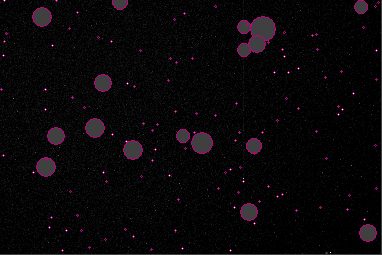 |
| Raw CCD Image as above |
| Raw Image - showing
Inventory Stars (CCDSoft, Software Bisque) (Min. number of pixels above threshold = 10, Detection Threshold = 1.25 ) Note the increasing the min. number of pixels above threshold prevents the majority of the hot pixels from being picked up as Inventory Stars. This time 'Insert WCS' succeeds with a 9 star solution. |
 |
| Reduced Image Dark and Flat Frame correction of above Raw Image Notice that the original hot pixels are largely removed during image reduction |
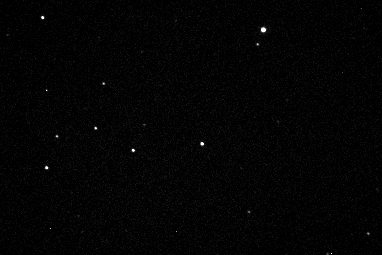 |
| Reduced CCD Image 20s, 2x2 binning, C Filter, 2008-09-11 21:40h UT (#301102) |
| Reduced Image -
showing Inventory Stars (CCDSoft, Software Bisque) (Min. number of pixels above threshold = 4, Detection Threshold = 1.25 ) Although a few hot pixels are still picked up as Inventory stars, 'Insert WCS' succeeds with a 12 star solution. |
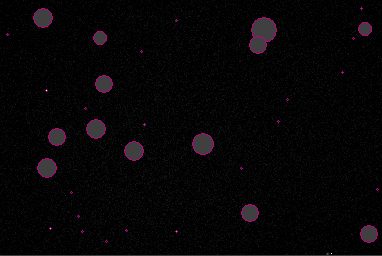 |
| Reduced CCD Image as above |
| Reduced Image -
showing Inventory Stars (CCDSoft, Software Bisque) (Min. number of pixels above threshold = 10, Detection Threshold = 1.25 ) Few if any hot pixels are picked up as Inventory stars with this less aggressive Star Detection Whilst 'Insert WCS' does succeed ok it now succeeds with only a 10 star solution compared to the 12 star solution above. |
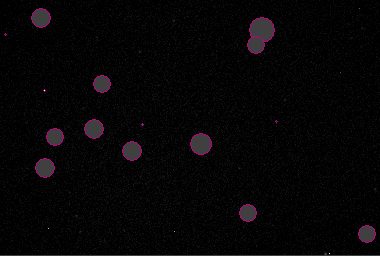 |
| Reduced CCD Image as above |
Link tests based on 46 locate images from Session S301 (-15 deg C). Exposure Times: 5s, 10s, 15s, 20s, 30s, C Filter
| Image Type |
Min. number of pixels above threshold |
Detection Threshold |
Link Success |
Success % |
Total Link Time |
Comment |
| Raw | 4 | 1.25 | 18 / 46 | 39.1% | 9m 30s | Worst |
| Raw | 9 | 1.25 | 25 / 46 | 53.3% | ||
| Raw | 10 | 1.15 | 33 / 46 | 71.7% | ||
| Raw | 10 | 1.20 | 32 / 46 | 69.6% | ||
| Raw | 10 | 1.25 | 32 / 46 | 69.6% | 1m 36s | Best |
| Raw | 10 | 1.35 | 31 / 46 | 67.4% |
Link tests based on 59 locate images from Session S294 (-20 deg C). Exposure Times: 5s, 10s, 15s, 20s, 30s, C Filter
| Image Type |
Min. number of pixels above threshold |
Detection Threshold |
Link Success |
Success % |
Total Link Time |
Comment |
| Raw | 4 | 1.25 | 53 / 59 | 89.8% | 4m 34s | Worst |
| Raw | 10 | 1.25 | 56 / 59 | 94.9% | 2m 23s | Best |
Link tests based on 169 locate images from Session S301 (-15 deg
C). Exposure Times: various. Filters : various
| Image Type |
Min. number of pixels above threshold |
Detection Threshold |
Link Success |
Success % |
Total Link Time |
Comment |
| Raw | 4 | 1.25 | 33 / 169 | 19.5% | Worst Raw | |
| Raw | 8 | 1.5 | 82 / 169 | 48.5% | ||
| Raw | 10 | 1.15 | 108 / 169 | 63.9% | ||
| Raw | 10 | 1.25 | 112 / 169 | 66.3% | ||
| Raw | 10 | 1.35 | 116 / 169 | 68.6% | Best Raw | |
| Raw | 10 | 2.5 | 48 / 169 | 28.4% | ||
| Raw | 10 | 5.0 | 56 / 169 | 33.1% | ||
| Raw (hot pixel repaired) | 4 | 1.25 | 92 / 169 | 54.4% | ||
| Raw (hot pixel repaired) | 10 | 1.25 | 140 / 169 | 82.8% | ||
| Reduced | 4 | 1.15 | 152 / 169 | 89.9% | ||
| Reduced | 4 | 1.25 | 154 / 169 | 91.1% | Best Reduced | |
| Reduced | 4 | 1.5 | 152 / 169 | 89.3% | ||
| Reduced | 5 | 1.3 | 151 / 169 | 89.9% | ||
| Reduced | 8 | 1.25 | 131 / 169 | 77.5% | ||
| Reduced | 10 | 1.25 | 131 / 169 | 77.5% | ||
| Reduced | 10 | 1.5 | 117 / 169 | 69.2% | ||
| Reduced | 10 | 2.5 | 88 / 169 | 52.1% | Worst Reduced |
Conclusion is that without image reduction or hot pixel repair, raw images need to be Image Linked using less aggressive star detection if they are to reliably link. However reduced image can stand more aggressive settings and indeed these are need for more reliable image linking and to pick up the maximum number of solution stars.
A solution is found whereby the Min. number of pixels above threshold value in the Source Extraction set up are set to 10 for realtime observatory work using Raw Images, but set back to 4 for later Image Analysis using Reduced Images.
Back to Top
Monitoring of variable star DY Per has been conducted for the last 9 months using V & R filters. During this time it had been noticed that R filter images had an unusual tendency to fail to link successfully during Insert WCS operations, even though the images contained lots of stars. Sometimes all 3 R filter images would fail to link, whilst 3 V filter images easily linked even though visually there was little to choose between the V and R filter images. Whilst it was noticed that the DY Per images did contain an unusually large number of (small) stars the reason behind the images failing to link was a mystery.
After determining a solution to make certain raw
images link, by increasing the Min. number of
pixels above threshold from 4 to 10, the same solution was tried out
on previous set of 'failed' DY Per images. The outcome was entirely
successful - previous failed R filter images all successfully linked.
By comparing the magnitude estimates made using V filter images, it was
confirmed that the 'Min. number of
pixels above threshold ' parameter had no impact on the magnitude estimates and
this did not impact photometric result.
Occasional failed links involving R filter images of BL Lac were also fixed by changing 'Min. number of pixels above threshold ' from 4 to 10.
| V Filter Image of DY
Per (Perseus) This V filter image links with an astrometric solution involving 46 stars |
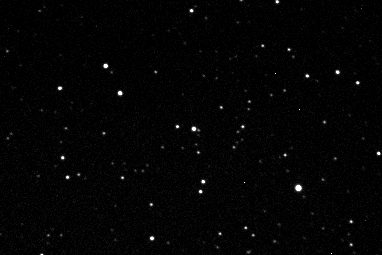 |
| CCD Image 60s, 2x2 binning, V Filter, 2008-02-11 23:08h UT (#262119) |
| R Filter Image of DY
Per (Perseus) This R filter image taken one minute after the above V filter image looks very similar yet it fails to successfully link. 2 other R filter images taken on the same night also failed to link |
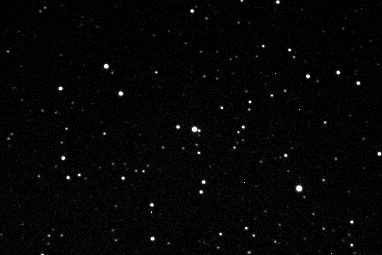 |
| CCD Image 45s, 2x2 binning, R Filter, 2008-02-11 23:09h UT (#262120) |
| Equivalent star field
in TheSky (Software Bisque) Around 50 USNO-B stars (with Mag < +15) are available for image linking The stars can be reasonable easily recognised in the raw image above, so why should Image Linking fail ? |
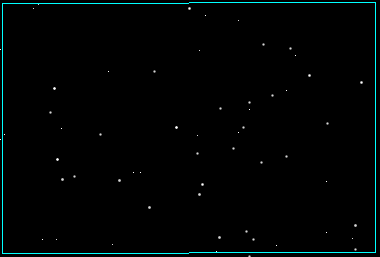 |
| Raw Image - showing
Inventory Stars (CCDSoft, Software Bisque) (Min. number of pixels above threshold = 4, Detection Threshold = 1.25 ) Note the large number of faint stars or hot pixels that are picked up as Inventory Stars. These are numerous enough to cause Image linking / Insert WCS to fail. |
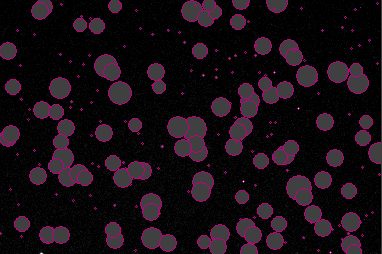 |
| R Filter CCD Image as above |
| Raw Image - showing
Inventory Stars (Min. number of pixels above threshold = 10, Detection Threshold = 1.25 ) Note the increasing the min. number of pixels above threshold prevents many of the faintest stars or hot pixels from being picked up as Inventory Stars. This time 'Insert WCS' successfully succeeds with a 4 9 star solution. |
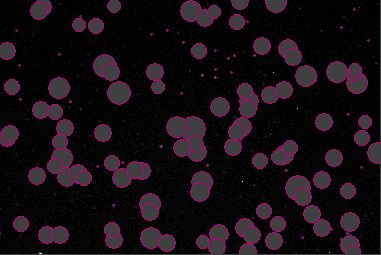 |
| R Filter CCD Image as above |
| Graphs showing
Photometric results from Per DY including data from newly linked R Filter images |
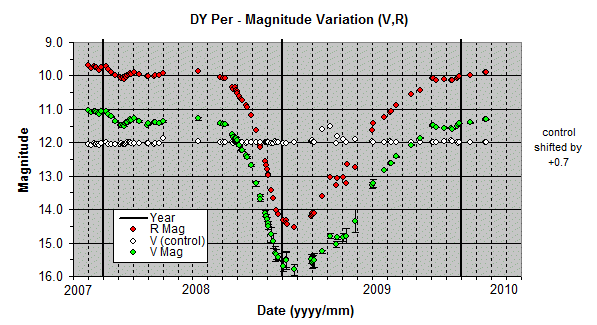 |
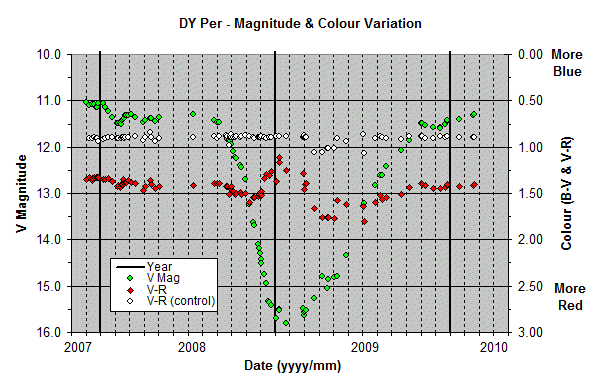 |
Back to Top
| This Web Page: | Notes - Session 301 (2008-09-11) |
| Last Updated : | 2015-05-16 |
| Site Owner : | David Richards |
| Home Page : | David's Astronomy Web Site |